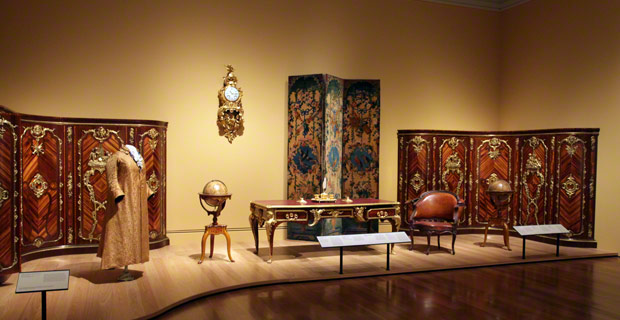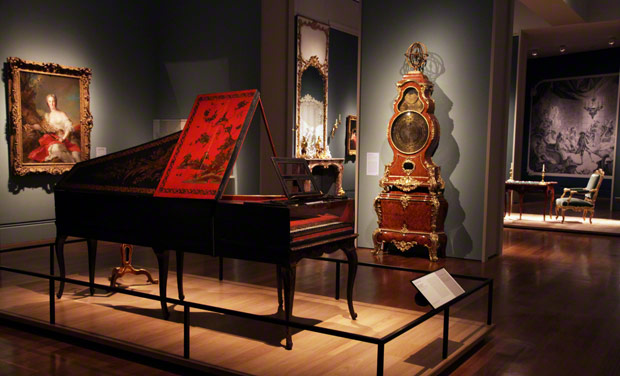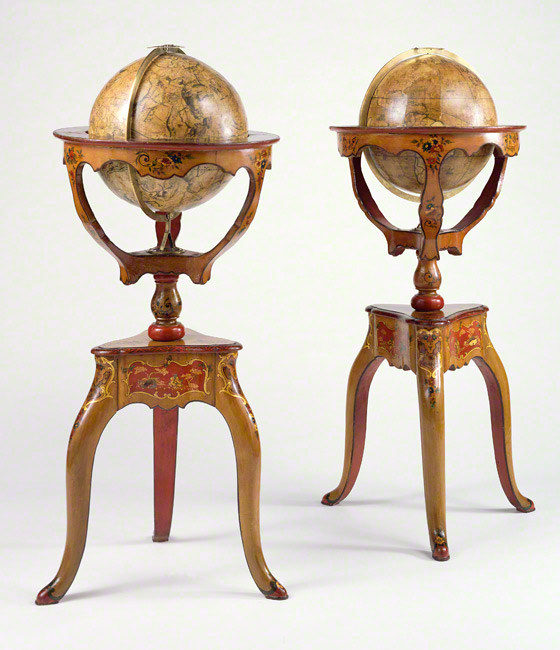
Installation view of Paris: Life & Luxury at the Getty Center showing the accoutrements of a gentleman’s study, including globes, a clock, and fine furniture
Enter Paris: Life & Luxury, closing this Sunday, and you’ll hear chimes pinging through the galleries from extravagant clocks that French aristocrats used to mark time more than two centuries ago.
Download (MP3 file, 5 MB) | Length: 5:24
The ornate instruments on walls and mantels in the galleries are the very same clocks that woke elite Parisians from their silk beds in the mid-18th century. They sounded as the well-heeled arranged their coiffures in their toilettes, planned travel across the seas, and gambled with guests in lavish salons.

Wall clock (pendule d’alcove), movement by Charles Voisin, clockmaker; clock case made at the Chantilly Porcelain Manufactory, about 1740. The J. Paul Getty Museum, 81.DB.81
The clocks reflect the exhibition’s theme of the “Four Times of Day,” which chronicles the activities of an ultrarich household from morning to night. Several of the timekeeping and travel-themed objects on display—six clocks and two globes—helped dukes and duchesses navigate their world and arrive on time to their soirees.
One of the most resplendent clocks is the wall clock (pendule à répétition, also sometimes called pendule d’alcove) ornamented with a monkey playing in a tree, yellow flowers, and a green dragon.
“It’s pure delight, whimsy in its ultimate form,” curator Charissa Bremer-David told me. This clock was useful if you wanted to, say, venture out of your bedchambers in the middle of the night for a cup of chocolat. Its mechanism, which sounded with quarter chimes every 15 minutes, had a little string that repeated the last chime when pulled. “So one didn’t have to go to the bother of striking a flint and lighting a candle to see the time,” Charissa explained. “One could hear the time.”

Wall clock (pendule à répétition), movement by Jean-Jacques Fiéffé, clockmaker; clock case by unknown ébéniste; possibly after Juste-Aurèle Meissonnier, designer, 1735–40. The J. Paul Getty Museum, 72.DB.89
The chiming, paired with ticking, were also reminders of mortality. The French clockmakers who constructed this splendid gilt-bronze Wall Clock (Pendule à répétition) playfully addressed that heady topic by letting Love conquer Time. It features two cherubs absconding with an hourglass and disarming Father Time.
Download (MP3 file, 2.1 MB) | Length: 2:17
The planisphere clock standing tall in an adjacent gallery would have made Father Time proud. This formidable nine-foot timepiece, whose mechanism was created by a scientific amateur, depicts the sphere of the earth flattened on a plane. (It was a guaranteed crowd-pleaser at dinner parties).
What did it do? The large dial with overlapping plates measured a 24-hour day and the months of the year, and depicted zodiac signs and constellations. Standing in your salon in Paris, you could know the time in Japon, La Californie, Perse, Londres, or Siam, to name a few.

Exhibition gallery featuring the planisphere clock, case attributed to Jean-Pierre Latz, furniture worker; movement (now missing) by Alexandre Fortier, clockmaker, 1745–49. The J. Paul Getty Museum, 74.DB.2. At center, a harpsichord by Johannes Goermans I from 1754. The Metropolitan Museum of Art, Gift of Susan Dwight Bliss, 1944 (44.157.8a-e)
Another dial showed the times of the eclipse of Jupiter’s moon Io, used to help calculate longitude on Earth. The planisphere tracked lunar phases, which helped maritime traders in northern France know the tidal calendar for port cities around the world. On the top of the towering timepiece sits an armillary model of a solar system with the sun at the center. (You won’t hear the planisphere’s chimes, sadly, as its movement is now missing).
All this data was quite useful for the clock’s first owner, the prince of Conti, the king’s minister of secret diplomacy. This orchestrator of clandestine operations needed to know when his messengers were arriving by ship in the ports of France, and when vessels were embarking for negotiations or wars.

Pair of globes made by Jean-Antoine Nollet, scientist, with maps by illustrators Louis Borde and Nicolas Bailleul le jeune, 1728–30. The J. Paul Getty Museum, 86.DH.705
Having a planisphere in your parlor was rare, but prosperous French men of the world would surely have a set of globes in their homes. During the age of exploration, terrestrial globes were not just for display, but essential business tools in home offices—think an 18th-century GPS. The outline of the Pacific Northwest in this globe from 1728 is vague, as mapmakers’ knowledge of the region was a bit cloudy.
Its pair, a celestial globe, was made by a scientist who taught physics to royal children. It maps the heavens and the signs of the zodiac.
Astrology was believed to predict personality in the early 18th century, but that superstition waned with the advent of the Age of Reason. A portrait of Gabriel Bernard de Rieux, a wealthy French magistrate (or judge), is the perfect picture of the rational man. This son of a financier poses in his study with the accoutrements of the intellectual: books, quill pens, and a globe (which you can explore here). I wonder how many chimes of the clock Rieux heard before the artist Maurice-Quentin de La Tour was finished and the gentleman could remove his wig and velvet robes and retire for the day.
After Sunday’s close—and a trip to Texas, where the exhibition will be presented at the MFA Houston as Life & Luxury: The Art of Living in Eighteenth-Century Paris—the globes and clocks will return to their permanent quarters in the South Pavilion, but the timepieces will fall quiet once again: being in perpetual service would damage their delicate mechanisms.
As a 21st-century souvenir of the exhibition’s 18th-century glamour, download this ringtone for your phone. It won’t make accepting calls any more fun, but it might turn heads—the ultimate goal of these luxurious accoutrements.
Hear the Ringtone
Get the Ringtone
iPhone
M4R file
Save to your computer desktop, then drag to iTunes.
Android
MP3 file
Save to the “ringtones” folder on your phone’s SD card.




What a wonderful exhibit! I am listening to the audio of the chimes as I wake up and get ready for my day. Thanks for the ringtones – what a nice gift from an enchanted time.
An excellent exhibit! The guided tour was nicely done! Fantastic idea to make a ring tone. I’ll share it with friends and family!
I love my 18th-century ringtone! Any chance we can get some more Getty-fueled system alert sounds for incoming notifications, txt messages, etc.?
Mike — So glad you like the ringtone! I’ve been using it too and it’s very elegant. We should make more tones. Any suggestions for special art-related text alerts?
-Annelisa/Iris editor
Thank you for the ringtone, quite fun to use.
Would be looking for a txt message notification as well 😉
Annelisa, how about extracting a text alert tone from this?
That’s a great pick! I will ask the “Paris” curator, Charissa Bremer-David of our decorative arts department. Our clocks don’t chime regularly — their delicate movements are kept silent for safe-keeping (which is why we jumped at the chance to record these clocks during their spring to life this summer)…but they are maintained, and I will seize the next opportunity to record!
Excellent. The iPhone 5 is rumored to be coming out next month; the timing might be impeccable.
I really like this post. Thanks for posting.